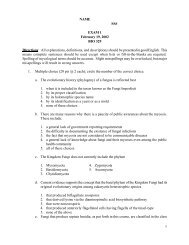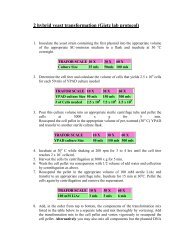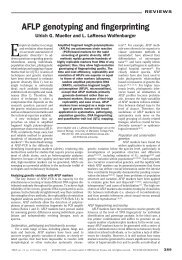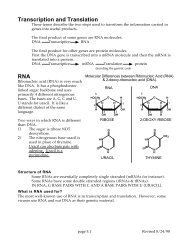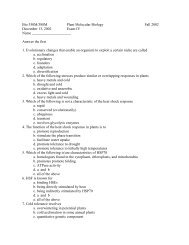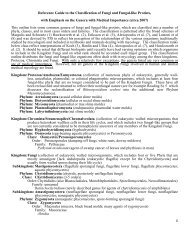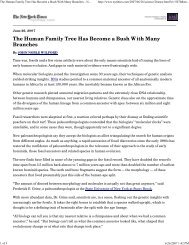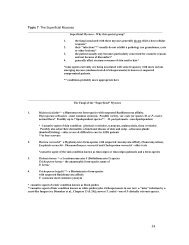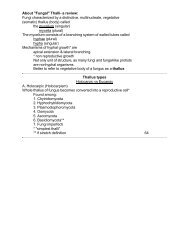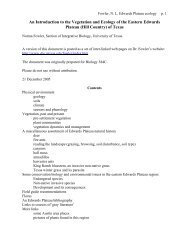My experience with Passiflora incarnata in Texas
My experience with Passiflora incarnata in Texas
My experience with Passiflora incarnata in Texas
You also want an ePaper? Increase the reach of your titles
YUMPU automatically turns print PDFs into web optimized ePapers that Google loves.
<strong>Passiflora</strong> Vol. 7, No. 1<br />
On the Fence...<br />
<strong>My</strong> <strong>experience</strong> <strong>with</strong> <strong>Passiflora</strong> <strong><strong>in</strong>carnata</strong> <strong>in</strong> <strong>Texas</strong><br />
by Jimmy Copp<strong>in</strong>ger<br />
<strong>My</strong> first encounter <strong>with</strong> <strong>Passiflora</strong> was <strong>in</strong> the late 1970’s/early<br />
1980’s when I ordered some seed from Park Seed Company.<br />
The seeds were of P. edulis and I managed to get two plants to<br />
live. I grew them <strong>in</strong> hang<strong>in</strong>g baskets <strong>with</strong> long wire hangers for<br />
them to climb on. I had very little <strong>in</strong>formation how to grow<br />
them and after two years <strong>with</strong>out flowers, I let the w<strong>in</strong>ter take<br />
them away.<br />
In 1984 I became <strong>in</strong>terested <strong>in</strong> wildflowers and bought some<br />
books on the subject. I found there was a Passionflower (P.<br />
<strong><strong>in</strong>carnata</strong>) that grew wild over much of the eastern and<br />
southern United States <strong>in</strong>clud<strong>in</strong>g the eastern half of <strong>Texas</strong>.<br />
This <strong>in</strong>cluded Coll<strong>in</strong> County <strong>in</strong> north-central <strong>Texas</strong> (near<br />
Dallas, approx. 34° N. latitude) where I live. I had never seen<br />
the plant and my <strong>in</strong>terest at that time did not compel me to go<br />
search<strong>in</strong>g for it.<br />
Sometime after this, a neighbor of m<strong>in</strong>e purchased some land<br />
<strong>in</strong> Hunt County which borders Coll<strong>in</strong> County on the east. She<br />
had found a passionflower on her property but did not know<br />
what it was. She brought a flower of it to one of her neighbors<br />
who also did not know what it was. They knew of my <strong>in</strong>terest<br />
<strong>in</strong> wildflowers so they came to me <strong>with</strong> it. I was able to<br />
immediately identify it as P. <strong><strong>in</strong>carnata</strong>. This was the first time<br />
I had ever seen a real flower of <strong>Passiflora</strong>.<br />
In January of 1993 I ordered a packet of <strong>Passiflora</strong> seeds from<br />
Thomson and Morgan. The packet was called “Passion Fruits<br />
of the World” which was a mixture of several species. I ended<br />
up <strong>with</strong> three plants. One was P. edulis and the two other were<br />
P. caerulea. All three were grown <strong>in</strong> pots on the patio.<br />
With a grow<strong>in</strong>g <strong>in</strong>terest <strong>in</strong> passionflowers, I turned my attention<br />
to the wild P. <strong><strong>in</strong>carnata</strong>. I wondered if the plant could be<br />
found <strong>in</strong> my area. Information <strong>in</strong> the wildflower books <strong>in</strong>dicated<br />
this possibility and my neighbors f<strong>in</strong>d <strong>in</strong> Hunt county<br />
was encourag<strong>in</strong>g. The only way for me to know for sure was<br />
to scout the area myself. I needed to know what k<strong>in</strong>d of places<br />
the plant could be found <strong>in</strong>. Geyata Ajilvsgi, <strong>in</strong> her book<br />
Wildflowers of <strong>Texas</strong>, describes the habitat of P. <strong><strong>in</strong>carnata</strong> as<br />
“various soils <strong>in</strong> pastures, old fields, fencerows, along stream<br />
banks and edges of woodlands and thickets”. She gave the<br />
bloom period as April to September.<br />
On July 19, 1993, I decided to take a bike ride <strong>in</strong> the rural area<br />
east of town search<strong>in</strong>g for P. <strong><strong>in</strong>carnata</strong>. After 6 miles my hope<br />
of f<strong>in</strong>d<strong>in</strong>g a passionflower was fad<strong>in</strong>g fast. Then, at the very<br />
end of a fence row, I looked, and there it was - P. <strong><strong>in</strong>carnata</strong>! The<br />
v<strong>in</strong>e had both flowers and fruit.<br />
I considered this plant to be an example of P. <strong><strong>in</strong>carnata</strong> <strong>in</strong> the<br />
wild for several reasons. First, the people who lived there were<br />
not aware of the plants existence — it was just a weed to them.<br />
Second, the land enclosed by the fence has been pasture land<br />
for many years and has rema<strong>in</strong>ed undisturbed. Third, a ditch<br />
between the road and fence was grown up <strong>with</strong> many weeds<br />
and the passionflower was grow<strong>in</strong>g among them. The v<strong>in</strong>e was<br />
also grow<strong>in</strong>g <strong>in</strong>side the fence sprawl<strong>in</strong>g over open ground.<br />
F<strong>in</strong>ally, I found sucker growths all along the fencerow to about<br />
a hundred feet south of the ma<strong>in</strong> v<strong>in</strong>e complex. I believe that<br />
this plant had been grow<strong>in</strong>g there for many, many years.<br />
I left the fruit on the v<strong>in</strong>e as long as I could so the seeds could<br />
develop and mature. Meanwhile, <strong>in</strong> October I discovered<br />
flower buds on one of the P. caerulea on the patio. One or two<br />
buds opened <strong>in</strong> late October giv<strong>in</strong>g me my first <strong>Passiflora</strong><br />
blooms. John Vanderplank’s book Passion Flowers, 1st edition,<br />
became part of my library that October. The really cold<br />
weather arrived <strong>in</strong> November, forc<strong>in</strong>g me to collect the P.<br />
<strong><strong>in</strong>carnata</strong> fruits. I planted the fresh seeds on November 14 and<br />
by the end of the month several had come up.<br />
In the spr<strong>in</strong>g of 1994, I planted one of the v<strong>in</strong>es on a cha<strong>in</strong>-l<strong>in</strong>k<br />
fence which runs north and south by the garden. This is my<br />
best v<strong>in</strong>e. It became well established <strong>in</strong> that year and produced<br />
flowers but no fruit. Sucker growths appeared <strong>in</strong> the garden<br />
several feet from the ma<strong>in</strong> stem. Several of these growths were<br />
dug up and moved to different locations around the yard. The<br />
plants are easy to get started this way.<br />
A misty early morn<strong>in</strong>g scene is the background for the 1996-97 Wild Louisiana<br />
Stamp, from a watercolor and acrylic pa<strong>in</strong>t<strong>in</strong>g by Rosemary John. The stamp<br />
portrays the strik<strong>in</strong>g Gulf Fritillary butterfly, Agraulis vanillae, on one of its<br />
native larval hostplants <strong>in</strong> Louisiana, Maypop (<strong>Passiflora</strong> <strong><strong>in</strong>carnata</strong>). To<br />
obta<strong>in</strong> pr<strong>in</strong>ts, stamps or posters, contact the artist at: P.O. Box 83933, Baton<br />
Rouge, LA 70884-3993, e-mail: zowood@unix1.sncc.lsu.edu.<br />
4 Spr<strong>in</strong>g 1997
Spr<strong>in</strong>g 1997<br />
<strong>Passiflora</strong><br />
In 1995, the v<strong>in</strong>e produced flowers and fruit <strong>with</strong> the first fruit<br />
com<strong>in</strong>g off <strong>in</strong> September. The sucker growths kept spread<strong>in</strong>g<br />
<strong>in</strong>to the garden but I just let them grow. I took some tomato<br />
cages and placed them over the growths so they would have<br />
someth<strong>in</strong>g to climb on. Only a few fruits were produced <strong>in</strong><br />
1995 but I had lots of flowers. The v<strong>in</strong>es are frequently visited<br />
by the Gulf Fritillary butterfly.<br />
The ma<strong>in</strong> v<strong>in</strong>e and its sucker growths reappeared early <strong>in</strong> 1996<br />
and occupied an area of 187 square feet (17.3 sq meters). In<br />
August, new growths appeared 19 feet (6.9 meters) south of the<br />
ma<strong>in</strong> stem. There were not many fruits set <strong>in</strong> the spr<strong>in</strong>g of<br />
1996. The first fruit to ripen fell from one of the sucker growths<br />
on July 13. It was 2.9 <strong>in</strong>ches (72 mm) long and had many black<br />
seeds. I planted about half of them <strong>in</strong> pots (after eat<strong>in</strong>g the<br />
fragrant pulp around them) and by the end of July several had<br />
come up.<br />
Fruit production <strong>in</strong>creased <strong>in</strong> July and cont<strong>in</strong>ued well <strong>in</strong>to<br />
September. I believe the bumblebees are responsible for this<br />
<strong>in</strong>crease. I did not notice any bumblebee activity on the flowers<br />
early <strong>in</strong> the season. But <strong>in</strong> July, August and September, there<br />
was a lot of bumblebee activity. They seem to be ideal<br />
poll<strong>in</strong>ators for P. <strong><strong>in</strong>carnata</strong>.<br />
There is one more <strong>in</strong>terest<strong>in</strong>g observation concern<strong>in</strong>g P.<br />
<strong><strong>in</strong>carnata</strong> that I would like to share. I ordered some P. <strong><strong>in</strong>carnata</strong><br />
seeds from Thomson and Morgan <strong>in</strong> 1994. I wanted to compare<br />
the plants and flowers from their seed to m<strong>in</strong>e to see if there<br />
would be any noticeable difference between them. The plants<br />
result<strong>in</strong>g from these seeds produced the first flowers <strong>in</strong> 1996<br />
and the <strong>in</strong>terest<strong>in</strong>g th<strong>in</strong>g here is that they were only two <strong>in</strong>ches<br />
(50 mm) across. <strong>My</strong> native <strong>Texas</strong> plants produce flowers that<br />
are three <strong>in</strong>ches (77 mm) across. A<br />
Jimmy Copp<strong>in</strong>ger, 117 W. Kirby St., Wylie, TX 75098<br />
Vol. 7, No. 1 5



